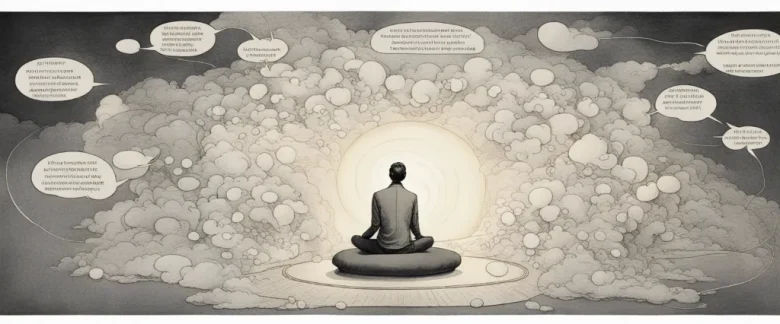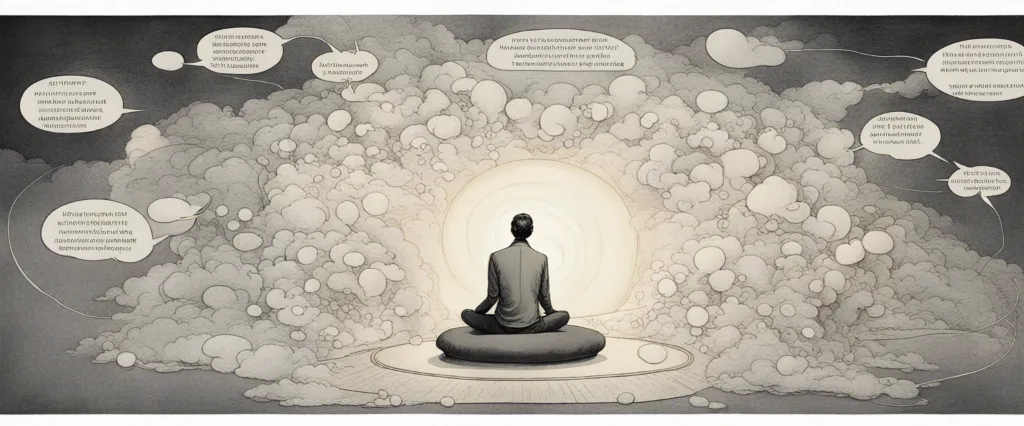In “The Mind Illuminated,” Culadasa (John Charles Yates), a highly respected meditation teacher with over four decades of experience, presents a comprehensive guide to meditation practice. The book offers a step-by-step approach to develop attentional skills, achieve deep states of concentration, and cultivate profound insight and wisdom. Culadasa’s unique blend of scientific understanding, traditional Buddhist teachings, and personal insights makes this book a valuable resource for both novice and advanced practitioners seeking to deepen their meditation practice. By providing clear instructions and exercises, Culadasa equips readers with the necessary tools to navigate the various stages of meditation and unlock the transformative potential of the mind.
Chapter 1: The Foundations of Mindfulness: Exploring the Basics of Meditation Practice
Chapter 1 of “The Mind Illuminated” by Culadasa (John Charles Yates) introduces the foundational concepts and basics of meditation practice. This chapter primarily focuses on understanding mindfulness and its role in the cultivation of attention and awareness.
The chapter begins by explaining the importance of developing mindfulness, which refers to the ability to pay attention to and be fully aware of the present moment. Mindfulness offers various benefits, such as increased focus, reduced distractions, emotional regulation, and improved introspection.
Culadasa emphasizes the necessity of developing a regular meditation practice and outlines the fundamental components involved. One aspect is setting aside dedicated time for meditation, ideally in the morning when the mind is fresh and less prone to distractions. Another essential element is creating a conducive environment that promotes relaxation and attentiveness.
The chapter then introduces the different stages of meditation practice, outlining the initial focus on developing stable attention. Culadasa suggests starting with a simple object of focus, such as the breath, and gradually training the mind to sustain attention on it for extended periods. This process involves acknowledging distractions as they arise and gently redirecting the attention back to the chosen object without judgment or frustration.
Furthermore, Culadasa discusses the different mental states individuals may experience during meditation, including mind-wandering, dullness, and agitation. He offers valuable techniques to combat these obstacles, such as labeling distractions, adjusting posture, and applying the appropriate level of effort.
Chapter 1 concludes by highlighting the potential challenges of meditation practice and the need for patience and perseverance. It emphasizes that progress is achievable with consistent effort and guidance.
Overall, this chapter provides readers with a solid foundation of mindfulness and meditation practice, setting the stage for a comprehensive exploration of the mind and its transformation through meditation in subsequent chapters of the book.
Chapter 2: Attention and Awareness: Cultivating the Powers of Concentration and Mindfulness
Chapter 2 of “The Mind Illuminated” by Culadasa (John Charles Yates) delves into the importance of attention and awareness in cultivating concentration and mindfulness. The chapter focuses on providing a groundwork for developing these essential mental skills.
The chapter begins by explaining that attention acts as a spotlight, gathering information from the internal and external world. With mindful awareness, attention is directed consciously and intentionally, allowing individuals to experience the present moment fully. The author emphasizes that sustained attention enables individuals to develop superior concentration, while mindful awareness fosters introspection and insight.
The chapter then introduces the concept of Stage 1 of meditation, wherein practitioners acquire basic attention skills. Here, individuals learn to continuously sustain their attention on a chosen object of focus, such as the breath, without being distracted by thoughts or sensations. The author provides practical instructions on building this foundation, including guidance on recognizing distractions and mind-wandering and bringing attention back to the chosen object.
Furthermore, Culadasa emphasizes the importance of maintaining awareness simultaneously with attention. Awareness serves as a comprehensive monitoring of one’s mental and physical states to avoid excessive narrowing of attention. This component reduces the likelihood of being caught up in thoughts or external stimuli that divert attention from the chosen object. The chapter offers techniques to broaden awareness, such as using peripheral awareness and introspective awareness.
Overall, Chapter 2 emphasizes the significance of attention and awareness in developing concentration and mindfulness. By mastering these essential mental skills, individuals can progress on their meditation journey to achieve higher stages of consciousness and greater clarity of mind.
Chapter 3: Developing Stable Attention: Strengthening the Mind’s Capacity to Stay Focused
Chapter 3 of “The Mind Illuminated” by Culadasa focuses on developing stable attention and strengthening the mind’s capacity to remain focused. In this chapter, Culadasa introduces the concept of developing exclusive attention, which is the ability to sustain attention on a chosen object without being distracted.
The chapter begins by highlighting the importance of developing exclusive attention as a foundation for further progress in meditation. Continuous attention is seen as the key to achieving deep states of concentration and eventually attaining higher levels of mindfulness.
Culadasa outlines a progressive training program to strengthen stable attention. He emphasizes the importance of practicing at the stage best suited to one’s current level of development. The stages include single-pointed attention, sustained attention, continuous attention, and exclusive attention. Each stage builds upon the previous one, gradually increasing the mind’s capacity to stay focused for extended periods.
The author introduces different techniques to overcome distractions and hindrances to exclusive attention. These techniques involve recognizing distractions without getting caught up in them and applying mental techniques to let go of distractions and maintain focus.
Culadasa also provides guidance on working with different kinds of distractions, emphasizing the importance of a balanced approach. He suggests that meditators should neither suppress nor indulge distractions but learn to skillfully redirect attention back to the chosen object.
By developing stable attention and strengthening the mind’s capacity to stay focused, meditators can cultivate greater clarity, concentration, and mindfulness. This chapter serves as a comprehensive guide for practitioners seeking to strengthen their attention and lay the groundwork for more profound meditation experiences.
Chapter 4: Overcoming Obstacles: Understanding and Addressing Challenges in Meditation

Chapter 4 of “The Mind Illuminated” by Culadasa (John Charles Yates) focuses on understanding and addressing challenges in meditation, providing valuable insights and techniques to overcome obstacles.
The chapter begins by explaining that difficulties in meditation are normal and to be expected, especially as one progresses and deepens their practice. These obstacles can range from restlessness and dullness to agitation and strong emotions.
Culadasa introduces the concept of “subtle distractions,” which are subtle mental objects that divert attention from the meditation object. He emphasizes the importance of cultivating introspective awareness, which allows practitioners to notice these distractions earlier and address them skillfully.
The chapter then elaborates on various challenges faced by meditators, such as forgetting, mind-wandering, and gross distractions. Culadasa emphasizes the use of the “Four-Step Transition” technique to handle these challenges effectively. This technique involves transitioning the attention from distractions to the breath in a systematic and gradual manner. He provides detailed descriptions of each step, facilitating a clear understanding for practitioners.
Culadasa also discusses overcoming dullness and drowsiness, as they hinder the meditative process. He introduces methods like introspective awareness, adjusting the body posture, and using visualizations or mental images to counteract dullness effectively.
Furthermore, the chapter explores overcoming restlessness and agitation through implementing relaxation techniques, maintaining mental stability, and developing discernment. Culadasa suggests recognizing and examining the root causes of restlessness to achieve peace and tranquility in meditation.
In summary, Chapter 4 of “The Mind Illuminated” examines the common obstacles encountered during meditation and presents practical strategies to overcome them. Culadasa provides valuable insights into understanding and addressing challenges, empowering practitioners to progress on their spiritual path with increased clarity and skill.
Chapter 5: The Five Hindrances: Recognizing and Overcoming Mental Obstacles to Progress
Chapter 5 of “The Mind Illuminated” by Culadasa focuses on understanding and overcoming the five hindrances that hinder our progress towards developing a focused and tranquil mind. These hindrances are mental obstacles that impede our meditation practice and hinder our ability to cultivate mindfulness.
The first hindrance discussed is sensual desire. It refers to being attached to sensory experiences and cravings for pleasure, which constantly distract us from maintaining a balanced state of mind. Culadasa advises that we need to cultivate contentment and develop a mind that can find joy and satisfaction within, rather than seeking it externally.
The second hindrance is ill-will or aversion. This hindrance can manifest as hostility, anger, resentment, or even boredom. Culadasa encourages us to address this hindrance by developing compassion and understanding towards others, as well as cultivating unconditional love and forgiveness.
The third hindrance discussed is sloth and torpor, which refer to feelings of laziness, inertia, and lack of energy. To overcome this hindrance, Culadasa recommends cultivating physical and mental energy through healthy habits, such as exercise, proper sleep, and maintaining a wholesome diet.
The fourth hindrance is restlessness and worry, which encompasses feelings of unease, anxiety, and a scattered mind. Culadasa explains that this hindrance can be managed by developing stability and calmness through deepening our concentration during meditation.
Finally, the fifth hindrance is doubt, which arises from uncertainty, skepticism, and the lack of confidence in oneself or the meditation practice. Culadasa suggests investigating our doubts and seeking guidance from experienced teachers or reliable sources to overcome this hindrance.
In conclusion, this chapter provides valuable insights into recognizing and overcoming the five hindrances that hinder our progress in meditation. By addressing these hindrances, we gradually develop a more focused and tranquil mind, which allows us to deepen our meditation practice and cultivate mindfulness.
Chapter 6: The Four-Stage Model of Meditation: Advancing Through the Stages of Practice
Chapter 6 of “The Mind Illuminated” introduces the Four-Stage Model of Meditation, which outlines the progressive stages of practice on the path to attaining mental clarity and deep concentration. The chapter emphasizes the importance of setting clear intentions and developing mindfulness.
The first stage, “Cultivating Powerful Introspective Awareness,” involves developing clarity of mind by anchoring attention to the breath. Practitioners learn to observe thoughts and distractions without getting caught up in them, building introspective awareness and increasing attention skills.
In the second stage, “Continuous Attention to the Meditation Object,” meditators work on stabilizing their attention by continuously focusing on the sensations of the breath. This involves gradually increasing the duration of uninterrupted attention, while maintaining the peripheral awareness of other sensations and thoughts.
Moving into the third stage, “Counteracting Gross Distractions,” practitioners work on recognizing and reducing gross distractions, which are more prominent thoughts or external stimuli that disrupt concentration. They develop the ability to quickly notice distractions and return their attention to the breath.
In the final stage, “Cultivating Subtle Distractions and Developing Exclusive Attention,” meditators focus on refining their concentration by reducing subtle distractions, which are more subtle thoughts or sensations that still hinder deep concentration. They aim to develop exclusive attention, where the meditation object becomes the sole focus of their awareness.
Throughout the chapter, Culadasa emphasizes the importance of cultivating metacognitive awareness, which involves simultaneously observing and examining the mind’s activities. By developing introspective awareness and consistently practicing mindfulness, meditators progress through the stages of meditation to attain deep concentration and achieve a state of illuminated mind.
Chapter 7: Cultivating Joy and Tranquility: Nurturing Positive Mental States in Meditation
Chapter 7 of “The Mind Illuminated” focuses on the cultivation of joy and tranquility through meditation. Culadasa (John Charles Yates) provides guidance on how to nurture positive mental states to enhance the meditation practice.
The chapter begins by emphasizing the importance of developing joy and tranquility as essential components of meditation and the path to enlightenment. The author explains that joy arises naturally when the mind becomes concentrated and focused. This joy is not dependent on external circumstances but rather emerges from within.
Culadasa then introduces the concept of “joyful effort,” which involves approaching meditation with enthusiasm and dedication. He encourages readers to set clear goals and apply consistent effort to achieve them, emphasizing the need for a balanced approach to avoid both striving and laziness.
The chapter also delves into the concept of tranquility, which is the natural result of cultivating joy and concentration. Tranquility entails a deep sense of calm and inner stillness that allows the mind to become more stable and less susceptible to distractions.
To cultivate joy and tranquility, the author introduces various meditation techniques. One method involves deliberately cultivating positive mental states through visualization, such as mentally imagining oneself in a peaceful and joyful environment. Another technique involves focusing on the breath to promote concentration, which leads to joy and tranquility.
Culadasa also provides guidance on how to deal with challenges that may arise during meditation, such as restlessness or dullness. He offers practical advice on recognizing and addressing these hindrances, suggesting specific antidotes to restore balance and foster positive mental states.
In summary, Chapter 7 of “The Mind Illuminated” explores the cultivation of joy and tranquility in meditation. Culadasa emphasizes the importance of setting clear goals, applying joyful effort, and practicing various meditation techniques to nurture positive mental states and enhance concentration. Through consistent effort and the cultivation of joy and tranquility, practitioners can deepen their meditation practice and progress on the path to enlightenment.

Chapter 8: Insight and Awakening: Deepening Understanding and Experiencing Spiritual Insight
Chapter 8 of “The Mind Illuminated” by Culadasa (John Charles Yates) is titled “Insight and Awakening: Deepening Understanding and Experiencing Spiritual Insight.” This chapter explores the process of insight and awakening in the context of deepening our understanding and experiencing spiritual insight.
The chapter begins by discussing the nature of insight and its significance in spiritual practice. Insight refers to gaining a direct and intuitive understanding of reality that goes beyond conceptual knowledge. It is through insight that we can experience awakening or a profound shift in our perception and understanding of the world.
Culadasa then introduces the concept of wisdom, which arises from the deepening of insight. Wisdom is described as a holistic understanding that integrates intellectual knowledge with direct experience, leading to profound transformative changes in our lives.
The chapter goes on to explain the different stages of insight development, which culminate in awakening or enlightenment. Culadasa provides clear instructions on how to cultivate insight throughout meditation practice, emphasizing the importance of developing sustained attention and deep awareness of the present moment.
Furthermore, the chapter delves into the obstacles and challenges that may arise during the insight journey, such as clinging to the self, fear, and doubt. Culadasa offers practical advice on how to navigate through these obstacles and continue progressing on the path of insight.
In conclusion, Chapter 8 of “The Mind Illuminated” explores the process of insight and awakening. It provides guidance on deepening understanding, cultivating spiritual insight, and overcoming obstacles along the way. By practicing mindfulness and developing sustained attention, readers can embark on a journey towards wisdom and transformation.
After Reading
In conclusion, “The Mind Illuminated” by Culadasa presents a comprehensive and practical guide to the practice of meditation and cultivating a focused, clear, and joyful mind. Through systematic stages, the book takes readers on a transformative journey, providing valuable insights into the workings of the mind and offering practical techniques to overcome obstacles and deepen one’s meditation practice. Culadasa’s expertise and deep understanding of both meditation and neuroscience make this book a valuable resource for those seeking to develop a profound state of mindfulness and achieve lasting inner peace and wisdom.
1. The Power of Now” by Eckhart Tolle: This book explores similar themes of mindfulness, presence, and achieving inner peace. Tolle guides readers on a journey to connect with the present moment, freeing themselves from the burdens of the past and future.
2. “Waking Up: A Guide to Spirituality Without Religion” by Sam Harris: Harris delves into the nature of consciousness and explores various ways of understanding spirituality from a secular perspective. In this thoughtful and thought-provoking book, he offers guidance on meditation and mindfulness practices.
3. “The Miracle of Mindfulness” by Thich Nhat Hanh: Written by Zen Master Thich Nhat Hanh, this book is a classic guide to mindfulness and meditation. It provides practical exercises and teachings that help readers cultivate awareness in their daily lives, fostering a deeper connection with themselves and the world.
4. “Siddhartha” by Hermann Hesse: A fictional work that delves into the spiritual journey of Siddhartha, the novel explores the quest for enlightenment and self-discovery. Through Siddhartha’s experiences, readers gain insights into the nature of existence, mindfulness, and the pursuit of inner peace.
5. “Cutting Through Spiritual Materialism” by Chögyam Trungpa: This book offers a critical exploration of the pitfalls and misconceptions that can arise on the spiritual journey. Trungpa provides valuable insights into ego, attachment, and the genuine path to awakening, encouraging readers to cultivate authenticity and sincerity in their spiritual practice.




